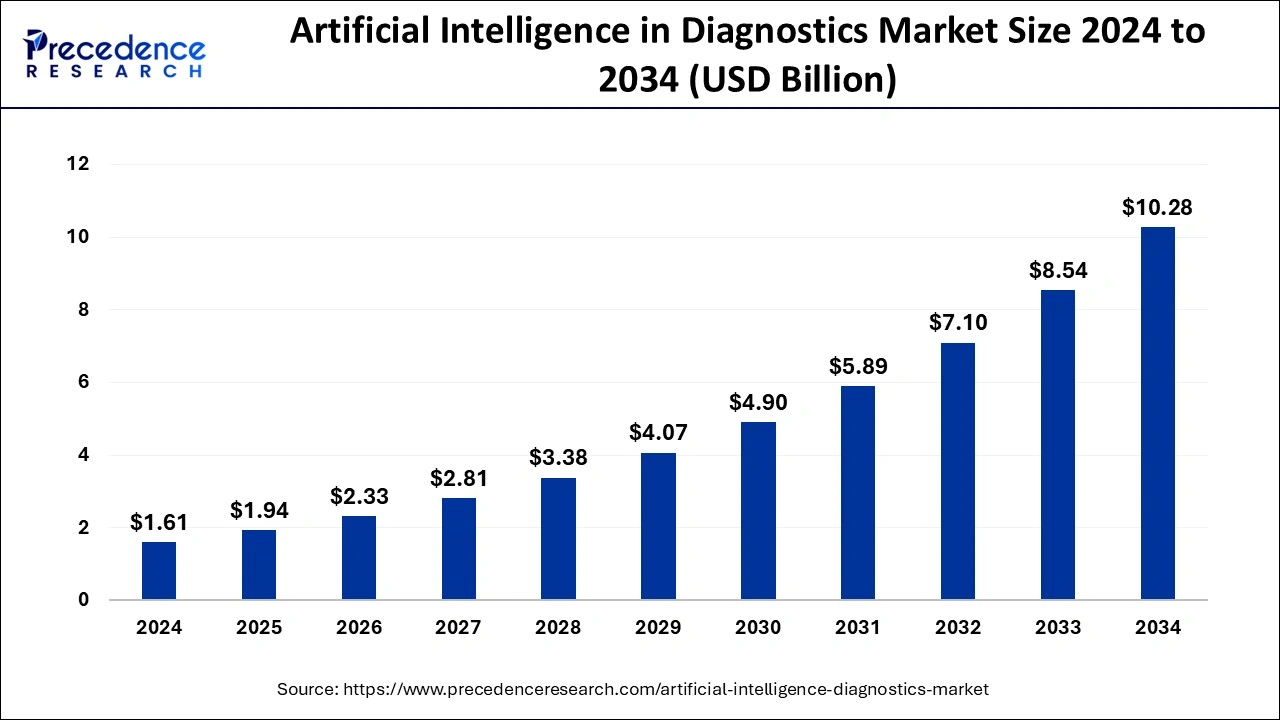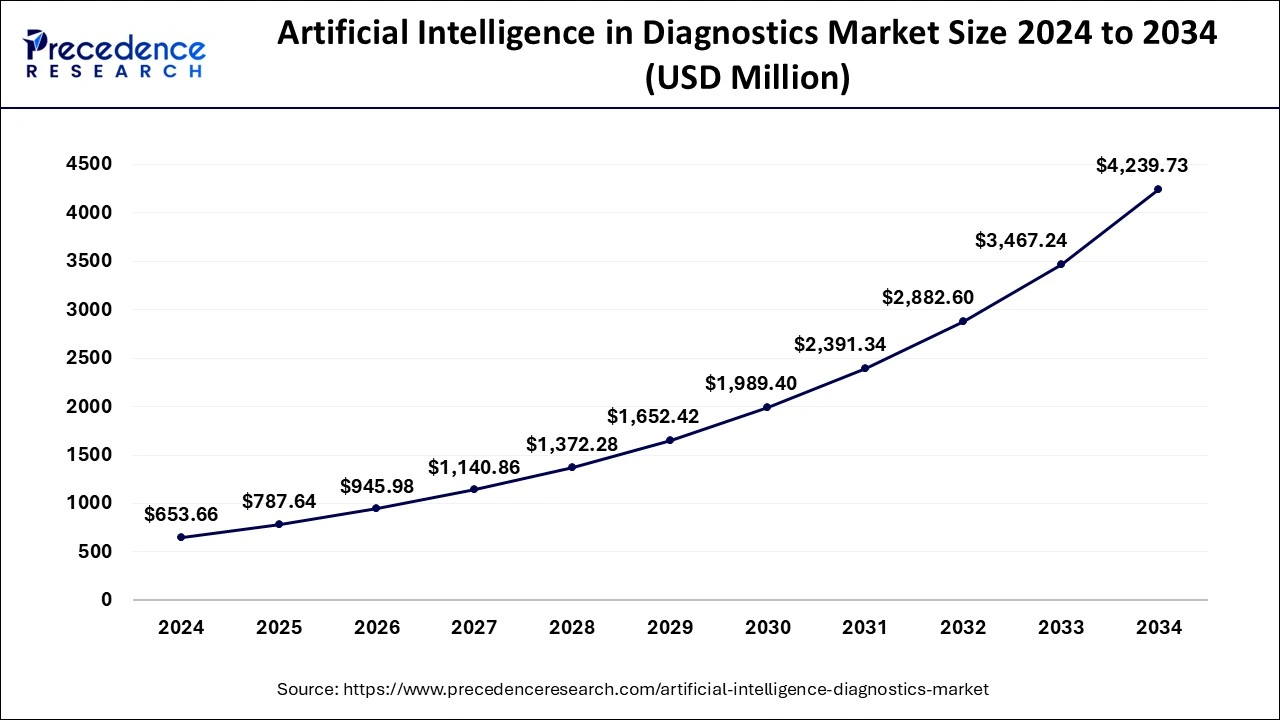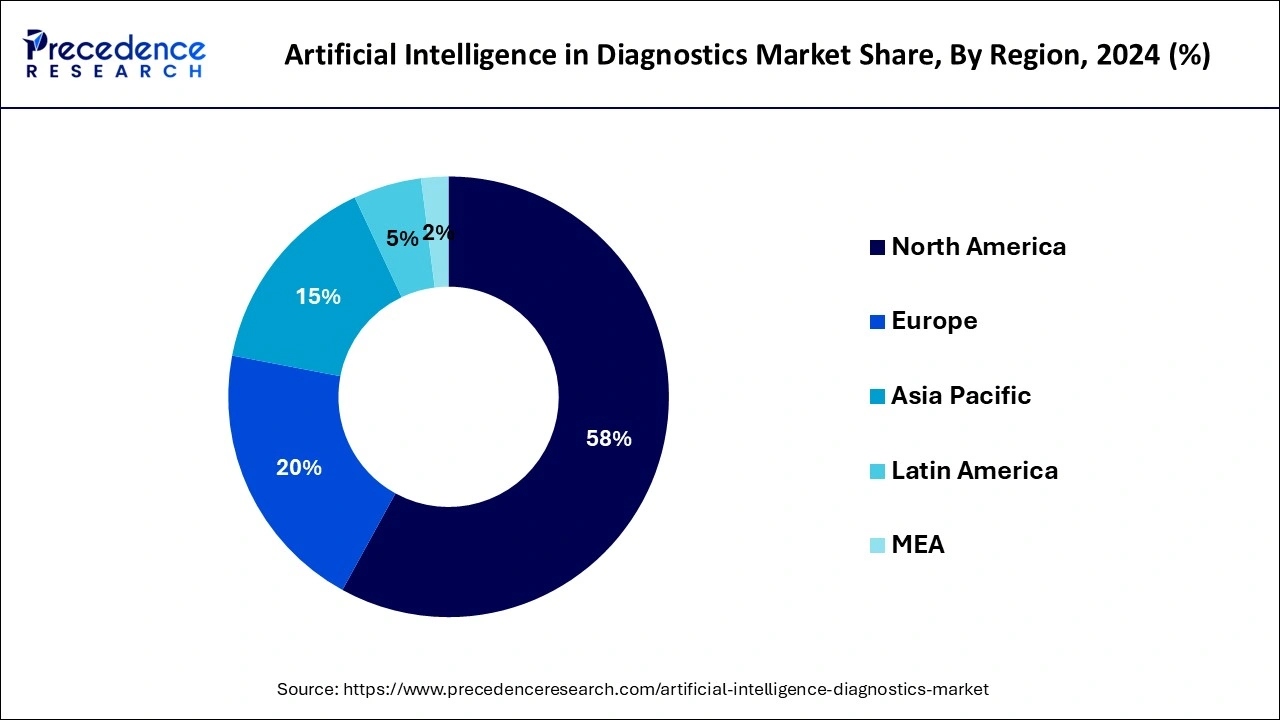August 2024
The global artificial intelligence in diagnostics market size was accounted for USD 1.61 billion in 2024, grew to USD 1.94 billion in 2025 and is predicted to surpass around USD 10.28 billion by 2034, representing a healthy CAGR of 20.37% between 2025 and 2034. The North America artificial intelligence in diagnostics market size was calculated at USD 930 million in 2024 and is expected to grow at a fastest CAGR of 20.51% during the forecast year.
The global artificial intelligence in diagnostics market size was estimated at USD 1.61 billion in 2024 and is anticipated to reach around USD 10.28 billion by 2034, expanding at a CAGR of 20.37% from 2025 to 2034. The rising adoption of AI in diagnostics market is owing to the high precision and improved outcomes provided by the AI tools for patients.

The U.S. artificial intelligence in diagnostics market size was evaluated at USD 653.66 million in 2024 and is predicted to be worth around USD 4239.73 million by 2034, rising at a CAGR of 20.63% from 2025 to 2034

North America dominated the market with a revenue share of 58% in 2024. With the presence of key market players and cutting-edge advancements in technologies integrated with AI-powered tools has expanded the market growth in this region. The rise in investments in R&D, support from government initiatives and increased fundings from private and public organizations for producing AI-enhanced diagnostic tools is strengthening the industries in the region.
Asia Pacific is anticipated to be the fastest growing region in the artificial intelligence in diagnostics market over the forecast period. The rising prevalence of chronic and non-communicable diseases is creating the demand for AI-powered diagnostic tools in the region. With the increasing adoptions of diagnostic tools paired with AI and machine learning platforms by the industries and the healthcare professionals in this region to provide accurate results and enhancing efficiency of diagnosing patients is fuelling the market growth. Moreover, the increasing investments in R&D, the strategic collaborations among companies and the rise in clinical stage development programs in developing countries is expected to boost the market growth of this region in the imminent years.

Medical diagnosis refers to the process of determining a disease or condition that matches with an individual’s symptoms and signs. The diagnostic procedures can be of different types such as laboratory tests (blood, urine), imaging tests (PET, CT scan, MRI), endoscopy. The process of diagnosing and determining the results of these tests can be complicated and may lead to misdiagnosis.
In today’s AI-driven world, the use of deep learning algorithms and AI tools in diagnostics can improve the accuracy, speed and efficiency for diagnosing patients with minimal errors. The introduction of AI and machine learning tools in diagnostics is transforming the healthcare industry by supporting the doctors in advanced disease diagnosis and providing personalized treatments to patients with better judgements and quick results.
The application of AI tools in diagnostics is assisting in analysing medical images for examining disease progression, predicting patient outcomes, processing and storing of patient data which includes electronic health records (EHRs), identifying patterns and anomalies in patient data and symptom checkers for providing potential diagnosis. The advances in digital biomarkers technology which uses real-time monitoring systems for early disease diagnosis and prediction has also enhanced the AI in diagnostics market growth.
| Report Coverage | Details |
| Market Size in 2024 | USD 1.61 billion |
| Market Size in 2025 | USD 1.94 billion |
| Market Size by 2034 | USD 10.28 billion |
| Growth Rate from 2025 to 2034 | CAGR of 20.37% |
| Largest Market | North America |
| Base Year | 2024 |
| Forecast Period | 2025 to 2034 |
| Segments Covered | By Component Type, and By Diagnosis Type |
| Regions Covered | North America, Europe, Asia-Pacific, Latin America, and Middle East & Africa |
Increased demand for AI-driven diagnostic techniques
The high speed accuracy and efficiency with minimal errors offered by utilizing AI-driven tools in medical diagnostics procedures is gaining popularity among the patients and healthcare providers. These tools are aiding in monitoring disease progression, real-time analysis and disease prognosis thereby driving the market growth.
High developmental and conservation costs
The installation of AI and machine learning tools in industrial and healthcare settings followed by the timely upgrades and maintenance costs is steep and not affordable owing to the low investments and capital of small and mid-sized organisations which is expected to hamper the market growth. Also the lack of interest of government bodies in increasing expenditure for introducing and developing AI-driven tools is costing the private consumers.
Rising investments and technological advancements:
The rise in investments and fundings by public and private sectors as well as the collaborations among industries, research institutions and academia for advancing the applications of AI tools in diagnostic procedures is expected to create opportunities for growth in the market during the forecast period.
Many corporations are designing software solutions for different healthcare applications which in turn encouraging the development of the software segment. Budding acceptance of AI-driven healthcare operational support and healthcare informatics solutions by means of healthcare service suppliers and hospitals is projected to enhance the growth of services during years to come.
The snowballing requirement for cloud-based and AI-powered augmented diagnostic solutions that aid in enhancing diagnostic precision during inferring medical images of a patient is flourishing the growth of the segment. Besides, the introduction of cutting-edge AI software in diagnostics comprising a combination of numerous data sources like CT, MRI, proteomics, genomics and patient data that helps in effectively detecting sickness and evaluating its development is also projected to push the growth of the market.
Based on component, the software segment dominated the market in 2024. The need for development of sophisticated software platforms for diagnostic applications with the integration of machine learning and AI tools is boosting the market growth. With the empowerment of diagnostic innovations through AI-powered algorithms and tools for various applications such as image analysis, predictive analytics, natural language processing (NLP), in digital biomarkers and telemedicine integration is uplifting the development of cutting edge software platforms. For instance, NVIDIA, a leading global corporation in AI technology has enhanced diagnostic accuracy in medical imaging by identifying patterns overlooked by the human eye with its AI-powered systems.
AI has the prospective to substitute plentiful of the routine characterization, detection, and quantification jobs presently accomplished by radiologist with the help of cognitive capability also complete the data mining of medical records (electronic) in the procedure. Among different types of diagnostics segment neurology held a market share of more than 23% in 2019. Further, radiology is anticipated to be the fastest progressing type on account of growing improvement of AI-based software existing for diagnostic imaging. The neurology amounts for greatest number of regulatory approvals occupying for about 18% of the total AI-based medical diagnostics platform.
The neurology segment is dominating the market in the diagnosis type segment. The failed attempts in developing a potential cure and treatments for neurological disorders is promoting the use of AI-driven tools for enhancing diagnostic procedures, disease prognosis, progression monitoring and providing personalized treatment plans. The integration of AI with diagnostics for developing treatments for neurological diseases is expanding the market growth of this segment. For instance, in Dec 2023, Quibim a company using best-in-class imaging softwares through AI techniques is enhancing brain MRI analysis by launching its propreitary QP-Brain which is an AI-powered tool providing a better understanding of brain atrophy and lesions through calculable evaluations for enhanced detection.
The radiology segment is expected to be the fastest growing segment by diagnosis type. The integration of AI tools in radiology has enhanced diagnostics with improved efficiency and accuracy making them popular among radiologists. From detecting abnormalities, improve image quality, supporting early treatment, real-time diagnosis and streamlining workflows with help of AI tools in radiology is boosting the market growth of this segment.
Reinforcing tactical collaborations and partnerships amongst several health facilities and AI solution suppliers is another aspect confidently purring market growth. For occurrence, in August 2019, Boston based Partners HealthCare partnered with FUJIFILM SonoSite, Inc. in order to implement artificial intelligence to portable ultrasound technology beneficial for point-of-care testing. In this co-operation, the datasets, clinical expertise, and IT infrastructure of Partners HealthCare is planned to practice with portable ultrasound technology of FUJIFILM in order to develop AI-powered devices.
Lately, artificial intelligence research division of the Google started its Google Deep mind Health project. This project comprises data mining of medical records to offer improved and quick health services. Improvement of such technically progressed data solutions and software and are projected to accelerate the growth of the market across the globe. Nevertheless, high capital constraint may generate affordability concerns and hinder the growth of the industry to some extent.
By Component
By Diagnosis Type
By Regional Outlook
For inquiries regarding discounts, bulk purchases, or customization requests, please contact us at sales@precedenceresearch.com
No cookie-cutter, only authentic analysis – take the 1st step to become a Precedence Research client
August 2024
September 2024
April 2025
December 2024